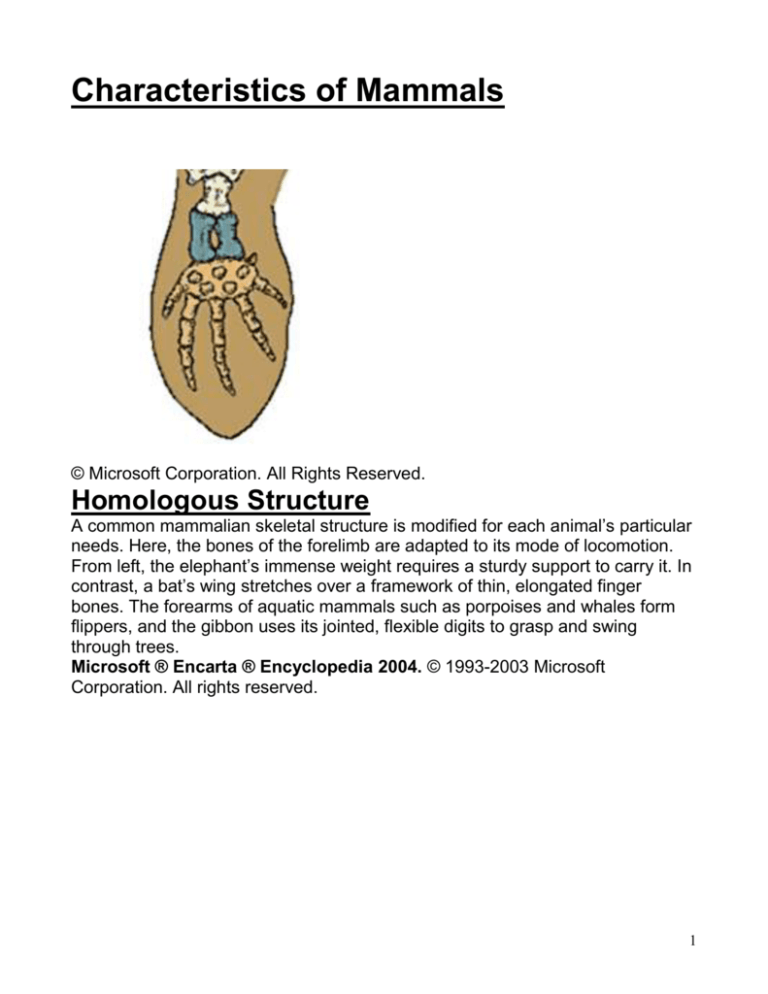
Characteristics of Mammals
© Microsoft Corporation. All Rights Reserved.
Homologous Structure
A common mammalian skeletal structure is modified for each animal’s particular
needs. Here, the bones of the forelimb are adapted to its mode of locomotion.
From left, the elephant’s immense weight requires a sturdy support to carry it. In
contrast, a bat’s wing stretches over a framework of thin, elongated finger
bones. The forearms of aquatic mammals such as porpoises and whales form
flippers, and the gibbon uses its jointed, flexible digits to grasp and swing
through trees.
Microsoft ® Encarta ® Encyclopedia 2004. © 1993-2003 Microsoft
Corporation. All rights reserved.
1
Oxford Scientific Films
Nursing Young
Unique to mammalian females are the milk-secreting, or mammary, glands that
give the class its name. Milk provides complete nourishment, including water, for
the young. A mother giraffe usually nurses her calf for 9 to 10 months, until its
body can metabolize the leafy diet of its parents. Mammal babies lacking the
sucking reflex at birth generally do not survive.
Microsoft ® Encarta ® Encyclopedia 2004. © 1993-2003 Microsoft
Corporation. All rights reserved.
2
Oxford Scientific Films/Mike Birkhead
Four Limbs
Most mammals have four appendages, usually legs. These may be modified for
walking upright, as in human beings, whose upper legs and knees articulate at
an angle that supports their weight with most stability; swimming, as in whales,
whose vestigial hind legs are still present in the skeleton; or flying, as in bats,
whose metacarpal bones are webbed with skin.
Microsoft ® Encarta ® Encyclopedia 2004. © 1993-2003 Microsoft
Corporation. All rights reserved.
3
Oxford Scientific Films/Kathie Atkinson
Helpless at Birth
Although this two-month-old parma wallaby joey successfully completed a blind
journey from its mother’s birth canal to her pouch without help, it would not
survive without her. All mammals, with the exception of egg-laying monotremes,
are born alive, but they complete only partial development inside the womb. The
young must be fed and protected sometimes for years before they can fend for
themselves.
Microsoft ® Encarta ® Encyclopedia 2004. © 1993-2003 Microsoft
Corporation. All rights reserved.
4
Dorling Kindersley
Large Brains
An interior view of the skull of a baboon reveals an enlarged brain case, sinus,
and oral cavities. These large cavities are specialized for receiving and
analysing sensory input from a variety of sources. The brain, the ultimate
endpoint for all sensory signals, is proportionately larger in mammals than in any
other group of animals.
Microsoft ® Encarta ® Encyclopedia 2004. © 1993-2003 Microsoft
Corporation. All rights reserved.
5
Oxford Scientific Films/F. Schneidermeyer
Hair All Over
The bodies of mammals are covered with hairs, filaments of dead cells
strengthened with keratin, that emerge from the skin. Closely spaced, they
constitute a fur coat. Kinky and matted, they form wool. Hair serves as
insulation, protection, water repellent, and, in the case of the porcupine, whose
hairs are coarse, stiff, and pointed, as defence. Some mammals have lost their
fur through evolution. A layer of insulating blubber, for example, takes the
protective place of hair in whales.
Microsoft ® Encarta ® Encyclopedia 2004. © 1993-2003 Microsoft
Corporation. All rights reserved.
6










